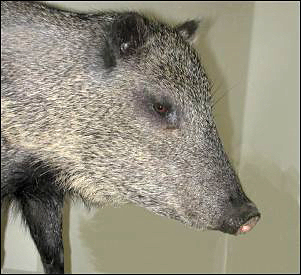

Are alien forces ripping up our prickly pear patches? Close, because more than likely a herd of javelina has stormed through this all-you-can-eat cactus buffet, a diet some say accounts for their ornery disposition. The name javelina is derived from the Spanish word jabalina, or "javelin", for its spear-like tusks.
These peccaries are recent arrivals, originating in South America. They
seem right at home in our badlands of scrub brush, cactus, searing midday temperatures,
and sparse water. Despite the rather low nutritional level of prickly-pear cacti, the
javelina do well, taking in stride its harsh chemicals such as oxalic acid, not to
mention treacherous spines. Javelinas seem to prefer this plant over all others during
the dry season, probably for the water content. A javelina can go days without any
other source of water. So, the next time you find yourself cursing at prickly-pear
cacti spread across your path, keep in mind that this vicious plant provides enough
water for our aliens to survive our Chihuahuan Desert heat.

Contributor: Helen Brewer, Student, University of Texas at El Paso.
Desert Diary is a joint production of the Centennial Museum and KTEP National Public Radio at the University of Texas at El Paso.

Javelina (Pecari tajacu) mount from Centennial Museum exhibit.
Feldhamer, G. A., L. C. Drickamer, S. H. Vessey, and J. F Merritt. 1999. Mammalogy. McGraw Hill, Boston. 563 pp.
Fisher, R. A., Sr. 1957. The guide to javelina. Naylor Publication, San Antonio. 208 pp.
Ultimate Ungulate Page, information and links.